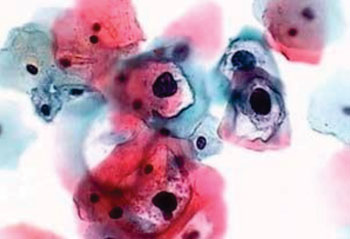Combining Two Diagnostic Tests Drastically Reduces Cancer Miss Rates
By LabMedica International staff writers
Posted on 17 May 2016
The Papanicolaou (Pap) test is recommended for women between 21 and 65 years old as a screening test for cervical cancer. Women 30 and older who are negative on co-testing may wait as long as five years for their next testing, but physicians still recommend annual examinations.Posted on 17 May 2016
In recent years, high-risk human papillomavirus (hrHPV) testing for triaging atypical squamous cells of undetermined significance and co-testing with cytology have been implemented in clinical practice. However, clinical data for primary screening with human papillomavirus (HPV) testing alone are currently lacking.

Image: A photomicrograph of an abnormal Pap smear showing changes consistent with Human Papilloma Virus (HPV) and Mild Dysplasia. Note the irregular perinuclear cytoplasmic clearing, which is the key characteristic of identifying HPV visually on a Pap smear (Photo courtesy of Dr. Cynthia D Booth, MD).
Scientists at the Houston Methodist Hospital (Houston, TX, USA) and their colleagues retrospectively reviewed the correlation of cytology, histology, and hrHPV testing through the use of a cytology laboratory quality assurance database with 130,648 Papanicolaou (Pap) tests interpreted at the BioReference Laboratories (Houston, TX, USA) and Houston Methodist Hospital between March 1, 2013, and June 30, 2014. Among the 47,499 patients who had undergone cytology-HPV co-testing, 1,654 underwent follow-up biopsies.
The sensitivities of the hrHPV and Pap tests were 80.8% and 81.2%, respectively, for detecting any type of cervicovaginal dysplasia and 91.3% and 90.9%, respectively, for high-grade cervicovaginal lesions. For the 253 biopsy-confirmed high-grade cervicovaginal lesions (cervical intraepithelial neoplasia grade 2+, adenocarcinoma in situ, or carcinoma), the false-negative rates for hrHPV and Pap tests were 8.7% and 9.1%, respectively. When they combined the tests, the teams found only three of the 253 cases were double negatives for both the Pap and hrHPV test. Therefore the false-negative rate for cytology-hrHPV co-testing was only 1.2%.
Dina Mody, MD, director of cytopathology at Houston Methodist Hospital and co-author of the study said, “We have known that neither test is perfect and misses a certain number of cases, but we did not realize until we analyzed the data just how impactful the combination of these tests would be. The numbers tell me that Obstetrics and Gynecology specialists need to regularly offer co-testing, and woman age 30 or older need to proactively request co-testing.” The study was published in the May 2016 issue of the journal Cancer Cytopathology.
Related Links:
Houston Methodist Hospital
BioReference Laboratories













